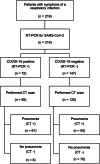Evaluation of patients with respiratory infections during the first pandemic wave in Germany: characteristics of COVID-19 versus non-COVID-19 patients
- PMID: 33568104
- PMCID: PMC7875010
- DOI: 10.1186/s12879-021-05829-x
Evaluation of patients with respiratory infections during the first pandemic wave in Germany: characteristics of COVID-19 versus non-COVID-19 patients
Abstract
Background: Characteristics of COVID-19 patients have mainly been reported within confirmed COVID-19 cohorts. By analyzing patients with respiratory infections in the emergency department during the first pandemic wave, we aim to assess differences in the characteristics of COVID-19 vs. Non-COVID-19 patients. This is particularly important regarding the second COVID-19 wave and the approaching influenza season.
Methods: We prospectively included 219 patients with suspected COVID-19 who received radiological imaging and RT-PCR for SARS-CoV-2. Demographic, clinical and laboratory parameters as well as RT-PCR results were used for subgroup analysis. Imaging data were reassessed using the following scoring system: 0 - not typical, 1 - possible, 2 - highly suspicious for COVID-19.
Results: COVID-19 was diagnosed in 72 (32,9%) patients. In three of them (4,2%) the initial RT-PCR was negative while initial CT scan revealed pneumonic findings. 111 (50,7%) patients, 61 of them (55,0%) COVID-19 positive, had evidence of pneumonia. Patients with COVID-19 pneumonia showed higher body temperature (37,7 ± 0,1 vs. 37,1 ± 0,1 °C; p = 0.0001) and LDH values (386,3 ± 27,1 vs. 310,4 ± 17,5 U/l; p = 0.012) as well as lower leukocytes (7,6 ± 0,5 vs. 10,1 ± 0,6G/l; p = 0.0003) than patients with other pneumonia. Among abnormal CT findings in COVID-19 patients, 57 (93,4%) were evaluated as highly suspicious or possible for COVID-19. In patients with negative RT-PCR and pneumonia, another third was evaluated as highly suspicious or possible for COVID-19 (14 out of 50; 28,0%). The sensitivity in the detection of patients requiring isolation was higher with initial chest CT than with initial RT-PCR (90,4% vs. 79,5%).
Conclusions: COVID-19 patients show typical clinical, laboratory and imaging parameters which enable a sensitive detection of patients who demand isolation measures due to COVID-19.
Keywords: COVID-19; Characteristics; Computed tomography; Laboratory parameters; Pneumonia; Respiratory infection; SARS-CoV2.
Conflict of interest statement
The authors declare that they have no competing interests.
Figures





Similar articles
-
Temporal relationship between serial RT-PCR results and serial chest CT imaging, and serial CT changes in coronavirus 2019 (COVID-19) pneumonia: a descriptive study of 155 cases in China.Eur Radiol. 2021 Mar;31(3):1175-1184. doi: 10.1007/s00330-020-07268-9. Epub 2020 Sep 15. Eur Radiol. 2021. PMID: 32930834 Free PMC article.
-
A comparison of clinical, laboratory and chest CT findings of laboratory-confirmed and clinically diagnosed COVID-19 patients at first admission.Diagn Interv Radiol. 2021 May;27(3):336-343. doi: 10.5152/dir.2020.20270. Diagn Interv Radiol. 2021. PMID: 32876570 Free PMC article.
-
Unenhanced computed tomography (CT) utility for triage at the emergency department during COVID-19 pandemic.Am J Emerg Med. 2021 Aug;46:260-265. doi: 10.1016/j.ajem.2020.07.058. Epub 2020 Jul 28. Am J Emerg Med. 2021. PMID: 33046310 Free PMC article.
-
Thoracic imaging tests for the diagnosis of COVID-19.Cochrane Database Syst Rev. 2020 Sep 30;9:CD013639. doi: 10.1002/14651858.CD013639.pub2. Cochrane Database Syst Rev. 2020. Update in: Cochrane Database Syst Rev. 2020 Nov 26;11:CD013639. doi: 10.1002/14651858.CD013639.pub3. PMID: 32997361 Updated.
-
Predictors of the chest CT score in COVID-19 patients: a cross-sectional study.Virol J. 2021 Nov 18;18(1):225. doi: 10.1186/s12985-021-01699-6. Virol J. 2021. PMID: 34794467 Free PMC article. Review.
Cited by
-
A new screening tool for SARS-CoV-2 infection based on self-reported patient clinical characteristics: the COV19-ID score.BMC Infect Dis. 2022 Feb 24;22(1):187. doi: 10.1186/s12879-022-07164-1. BMC Infect Dis. 2022. PMID: 35209872 Free PMC article.
-
Thoracic imaging tests for the diagnosis of COVID-19.Cochrane Database Syst Rev. 2022 May 16;5(5):CD013639. doi: 10.1002/14651858.CD013639.pub5. Cochrane Database Syst Rev. 2022. PMID: 35575286 Free PMC article.
-
Review of COVID-19 testing and diagnostic methods.Talanta. 2022 Jul 1;244:123409. doi: 10.1016/j.talanta.2022.123409. Epub 2022 Mar 31. Talanta. 2022. PMID: 35390680 Free PMC article. Review.
-
Comparison of temporal evolution of computed tomography imaging features in COVID-19 and influenza infections in a multicenter cohort study.Eur J Radiol Open. 2022;9:100431. doi: 10.1016/j.ejro.2022.100431. Epub 2022 Jun 24. Eur J Radiol Open. 2022. PMID: 35765661 Free PMC article.
-
Signs and symptoms to determine if a patient presenting in primary care or hospital outpatient settings has COVID-19.Cochrane Database Syst Rev. 2022 May 20;5(5):CD013665. doi: 10.1002/14651858.CD013665.pub3. Cochrane Database Syst Rev. 2022. PMID: 35593186 Free PMC article.
References
-
- WHO. Novel Coronavirus – China [Internet]. Available from: https://www.who.int/csr/don/12-january-2020-novel-coronavirus-china/en/
-
- WHO. Rolling updates on coronavirus disease (COVID-19) [Internet]. Available from: https://www.who.int/emergencies/diseases/novel-coronavirus-2019/events-a...
-
- WHO. WHO Director-General’s opening remarks at the media briefing on COVID-19 - 11 March 2020 [Internet]. Available from: https://www.who.int/dg/speeches/detail/who-director-general-s-opening-re...
MeSH terms
LinkOut - more resources
Full Text Sources
Other Literature Sources
Medical
Miscellaneous

